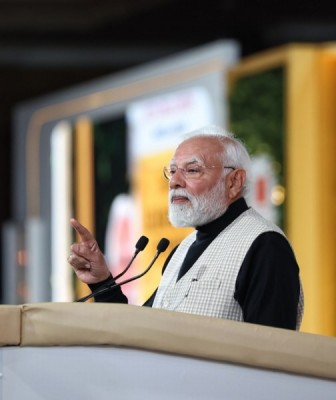
PAKISTAN-USA: Drone Strikes Escalate
On October 17, 2017, at least 11 suspected terrorists were killed when two United States (US) drones fired six missiles on their hideouts in the mountainous region of the Kurram Agency of the Federally Administered Tribal Areas (FATA), along the Pakistan-Afghanistan border.
On October 16, 2017, at least 20 suspected terrorists were killed in a similar US drone strike on another hideout in the same area. Four missiles were fired on a compound during the strike, in which suspected terrorists of the Haqqani Network were killed. According to media reports, the target of the attack was a Haqqani Network 'commander', Abu Bakar, who was killed along with his accomplices.
On September 15, 2017, three suspected terrorists were killed in a US drone attack in the Charmanak area of the Kurram Agency. "A remotely-piloted US aircraft fired two missiles at the home of Maulana Muhibullah," Kurram Agency Political Agent Baseer Khan Wazir stated, adding, "The Maulana, along with two others, was killed in the attack." Two Afghan Taliban sources later confirmed that Muhibullah was affiliated with the Haqqani Network "but wasn't a prominent figure".
According to partial data compiled by the South Asia Terrorism Portal (SATP), the US has carried out at least seven drone attacks inside Pakistan since the beginning of the current year (2017) resulting in at least 48 fatalities (data till October 29, 2017). During the corresponding period of 2016, there were just three such attacks, resulting in seven deaths. There were no further attacks through 2016.
The US first commenced drone strikes inside Pakistan on June 18, 2004, and has so far carried out at least 330 such strikes, resulting in over 2,861 fatalities (data till October 29, 2017).
There was a steep and sustained decline in number of such attacks since 2011 after a continuous escalation since 2008. Except for Washington's continuing flip-flop 'Pakistan policy' under former President Barrack Obama, there was nothing on the ground to justify the down trend in such attacks since 2011, as Pakistan continued to provide safe haven to Taliban and Haqqani network formations operating across its borders into Afghanistan.
When President Donald Trump assumed power in January 2017 and decided to re-configure America's 'Pakistan Policy', drone attacks were expectedly resumed. The first strike took place on March 2, 2017, killing two suspected terrorists in a border village along the AfPak border in FATA's Kurram Agency. Significantly, the last such attack had been recorded on May 21, 2016, in which Afghan Taliban chief Mullah Akhtar Mansour was killed in the Kuchaki area of Nushki District in Pakistan's Balochistan Province.
In the meantime, after almost six months of his Presidency, Trump announced his "new integrated strategy for the U.S. approach to South Asia" on August 21, 2017. In particular, the strategy outlined his approach to the Afghanistan-Pakistan conundrum, projecting a radical redirection in the US policy towards Pakistan. The policy statement observed,
.The next pillar of our new strategy is to change the approach and how to deal with Pakistan. We can no longer be silent about Pakistan's safe havens for terrorist organizations, the Taliban, and other groups that pose a threat to the region and beyond. Pakistan has much to gain from partnering with our effort in Afghanistan. It has much to lose by continuing to harbor criminals and terrorists.
Not surprisingly, there have been at least four reported drone attacks inside Pakistani territory within a span of just 70 days since the declaration of the new policy. A further surge in such attacks can be expected, as the US continues to harden its position on Pakistan. Indeed, US Secretary of State Rex Tillerson, who visited South Asia, between October 23-27, acknowledged on October 26, 2017, that he had told the Pakistan Government that Washington would implement its new strategy with or without Islamabad, because "this is what we think is necessary. And if you don't want to do that, don't feel you can do it, we'll adjust our tactics and our strategies to achieve the same objective a different way."
The increasingly inflexible US position, for the time being at least, has unnerved Pakistan. Unlike earlier instances of Pakistani protests against drone strikes as a violation of territorial integrity and sovereignty, this time the Pakistan establishment has out rightly denied the strikes within its territory in order to justify its claim that there are no terrorist safe havens within its borders. The Inter-Services Public Relations (ISPR) in a statement released on October 17, 2017, in the aftermath of October 16-17, drone attack thus claimed,
Military Operations are being conducted in Khost and Paktia, Afghanistan, by Resolute Support Mission (RSM) / Afghan Forces, opposite Kurram Agency. During last 24 hours, number of Air engagements has taken place in those areas inside Afghanistan with reports of heavy losses to Terrorists. As a follow up of COAS [Chief of Army Staff] visit to Afghanistan, coordination between the forces has enhanced. RSM timely shared details about the said operation within Afghan territory. There has been no air violation along Pak-Afg border in that area or any drone strike in Kurram Agency as being misreported by few.
The civilian Government too made an attempt to argue that there are no terror safe havens inside Pakistan, with Pakistan's Foreign Minister Khawaja Asif sharing a chart of drone attacks carried out over the past 12 years, from 2005 till October 15, 2017, inside the Pakistani territory, and tweeting on October 25:
12yrs drone attacks chart. If we have sanctuaries why frequency is sharply down. US won't hesitate attacking funeral, weddings to get targets.
The charade of denials may serve a domestic political agenda, allowing the Army and political leaderships in Pakistan to save face; however, it can only harden US attitudes further, as there can be little doubt in Washington where its precision strikes are hitting terrorist hideouts. Unless Islamabad executes an unlikely and radical turnaround of its policies supporting terrorism - at least across the border into Afghanistan - US drones are likely to strike targets in Pakistan with rising frequency.
Support Our Journalism
We cannot do without you.. your contribution supports unbiased journalism
IBNS is not driven by any ism- not wokeism, not racism, not skewed secularism, not hyper right-wing or left liberal ideals, nor by any hardline religious beliefs or hyper nationalism. We want to serve you good old objective news, as they are. We do not judge or preach. We let people decide for themselves. We only try to present factual and well-sourced news.







